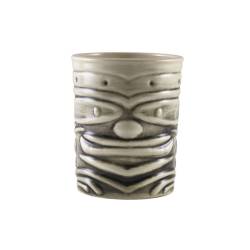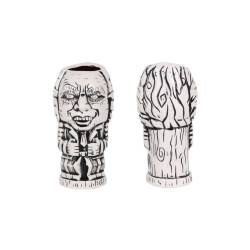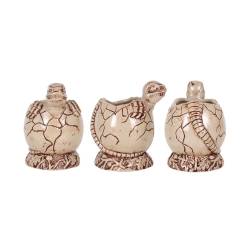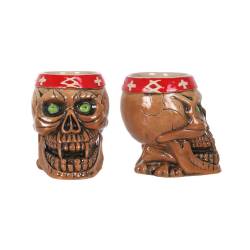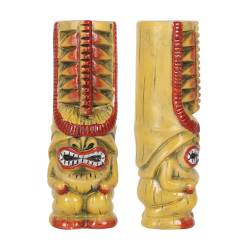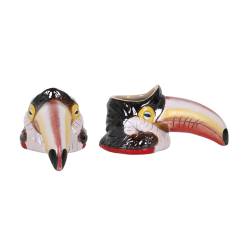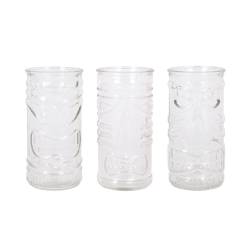Tiki culture, how and when the breakthrough happened
Finding tiki glasses on the market was not easy for many years. There were few manufacturers; the vast majority worked the ceramics and painted them by hand, leading costs to be very high. Even tiki culture, however, has evolved., anticipated by RGmania in the2011 edition of the Summer Drink&Eat Festival, which had tiki drinks as its theme.
In recent years much has changed: tiki-mania has in fact been cleared through customs starting with the bases of cocktails increasingly replaced with fresh, home-made products, thanks to the easier availability of exotic fruits throughout the year and the need for bartenders to address an increasingly demanding and knowledgeable public. Manufacturing companies also realized that tikis were not just a passing fad, but a business to be ridden. In addition to the ever-increasing use by beach clubs, tiki-inspired venues have thus sprung up to bring a breath of tropical air to the city, immersing people in exotic atmospheres amidst palm trees, colors and flower necklaces 365 days a year.
The materials of tiki mugs, tiki bars and collectors
As for the materials of tiki mugs, glass is less expensive and easier to produce, but also less distinctive. Ceramic and porcelain, on the other hand, are more expensive, but colors and designs can be appreciated more on them.
Penetration in tiki bars but not only is increasingly widespread, by now even many bar tools have tiki decorations; at the level of patterns there is now really for all tastes, from those who are falling in love with them to those who have known them for years and have a collection-it is, however, a type of glassware that is usually not purchased in large quantities, since uniqueness is one of the main characteristics. They tend to be patterned and colorful, RGLife has divided them into four categories starting with the newest ones available on our site.
Tiki mugs on totems, masks and deities.
The largest, most important and representative strand, from which the others probably originated as well, is the tikis dedicated to, and taking inspiration from, the totems and masks typical of Polynesian and overseas cultures (e.g., the Tiki Lono, the Tiki Rainbow, the Tiki Kaneand the Tiki Hakuna). Derived from the clash of nature and culture (demonstrations of which are the Tiki Shameful and the Tiki Aloha), their inspiration comes from beliefs and iconography: these are animal deities (Tiki Hanaka), masks (Tiki Mopei) fearsome (Tiki Brah, see also the category "skulls and pirates") but funny (theTiki Smile, theTiki Luckyand theTiki Molocai), inspired by the pagan gods anciently worshipped by Central American peoples and the atmospheres of oceanic areas such as Hawaii (theTiki Honoluluand theTiki Ku), tropical and Caribbean, but especially of Pacific atolls.
>>> See also the latest arrival: Tiki glass assorted decors cl 50.
Brightly colored and striking, original and sought-after, these highly detailed tiki mugs usually have the opening at the height of the character's skull, to keep the figure in evidence; among their distinguishing features is their whimsy, eccentricity and unusual character compared to the standards to which we are accustomed. They are therefore products designed for bartenders who like to offer a striking stage effect and serve bold and exotic, tropical and ultra-fresh drinks.
Tiki mugs about animals and natural elements
The other major categorization is that related to animals and natural elements, equally original models for those who prefer the appeal of natural elements to religious ones. The main features, however, do not change: vivid and bright colors, for a social and surprising effect ensured in tiki cocktails. The figure is also at the center of animal-shaped tikis, so as to emphasize their shape, as well as the more cartoonish than real connotation of what might be found in the iconographies of tribal paintings.
In this regard, the prime example is the Tiki Monkey to which, insofar as they in turn are shaped like monkeys, can be likened the Tiki Hasira and the Tiki Nyani; among RGmania's new arrivals we also find the toucan-shaped tiki and, moving into the natural realm, the egg-shaped tiki and the coconut-shaped tiki. A special case in point is the Buffalo tiki, which serves to introduce us to the next type.
The tiki mugs on skulls and pirates.
In fact, the tiki buffalo just mentioned has the appearance of a zombie, an apt mix for an unusual, sought-after and eccentric object.
Skulls and pirates are the other components of this tiki mug category, in which an already mentioned totem-skull, the Brah, finds its place. Still on skulls, here is the horrid Tiki Jua and the porcelain Tiki Skull ( since there is also the Tiki skull in glass) amazing thanks to the use of colors and attention to detail: just note the book at the base, which serves not only to balance the glass, but also to convey the idea of being in a mad professor's lab or an old haunted library.
As for pirates, the Tiki Barrel is shaped like a barrel with a hole in the side, lying down and covered with red crabs--not to be missed!
Tiki mugs about monsters (and more).
The fourth and final category we have arbitrarily identified consists of monsters and more.
The Tiki Monster is in fact made up of monsters and skeletons, ghosts and bones in plain sight, making it perfect not only for original drinks and tiki cocktails, but also for occasions such as Halloween or cocktail bars with a drink list explaining the history of the drinks. La Tiki Crazy on the other hand, has a gloomy, cartoonish look, while the Tiki Herman is inspired by Frankenstein's monster, with a grim expression and in an almost cartoonish version.
You just have to choose the tiki glass that best suits your venue, or that is still missing from your collection, from thewide assortment on our site!




